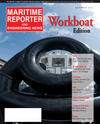
Page 37: of Maritime Reporter Magazine (November 2011)
Feature: Workboat Annual
Read this page in Pdf, Flash or Html5 edition of November 2011 Maritime Reporter Magazine
and ballast tanks ? one of the worst places for corrosion? that last for the life of the ship, or instead of requiring at-tention every three years, only need it every 15 years,? he says.?In terms of ship design and production, maintenance, pro-tection, and survivability, we?re trying to build things that last longer. And we?re looking at new tools that have a high return on investment, that can do a better or more efficient job for a ship?s crew, shipyard or contractor, because that will ultimately save the Navy money and increase our avail- ability,? he says. Schuette says ONR is studying different materials for ship construction, such as composites and titanium. ?We?ve al- ways thought that titanium is too expensive, but it?s stronger than steel and aluminum for its weight. It never corrodes and never needs paint. You can even recycle it at the end of its service life. Besides the very expensive aviation grade where saving weight is so important, there are other types of titanium that are not nearly as costly. So, when looking at total ownership costs, titanium might actually be the best choice. But at this point we simply don?t have enough in- formation to provide the ship designers. We want to learn everything we can about building with these materials so de- signers can make informed decisions.? PARTNERSHIPS ARE IMPORTANT ?We?re at our best when we?re working with large groups to look at problems from different perspectives,? Schuette says. Schuette says collaboration with the combatant com-manders and the operational commands is very important. ?We work with the senior leadership in the fleet. We?re talk- ing with the flag officers and the science advisors on their staffs to find very clever solutions to their requirements, and then we work with the acquisition community to help get that new technology into the field much quicker. We?re working with the Navy labs; Department of Energy labs; universities; the fleet, requirements and resource sponsors on the Chief of Naval Operations Staff, and the acquisition and test community. When you have rich and robust teams, you make tremendous progress in ways you didn?t antici- pate.? How does all this ultimately support warfighters? Schuette says ONR must balance the research between the warfighter of today, tomorrow, and the future. ?We like to work in all three spaces. But if it doesn?t support the warfighter, why do it??Captain Edward Lundquist, U.S. Navy (Ret.) is a principal science writer for MCR Federal LLC. November 2011www.marinelink.com 37MR Nov.11 # 5 (34-41):MR Template 11/7/2011 1:38 PM Page 37

 36
36

 38
38
